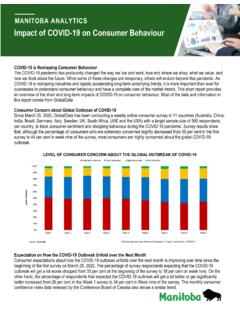Transcription of III – Which are the largest city economies in ... - blogs
1 20 PricewaterhouseCoopers UK Economic Outlook November 2009 III Which are the largest city economies in the world and how might this change by 2025? largest city economies by GDP in 2008 and 2025 in Annex Long-term historic trends in city populationsUrbanisation has been one of the major global themes of the past century and all the indications are that major cities will provide an increasing focus for global economic activity over the course of this century. In 1900, there were only 16 cities in the world with more than 1 million inhabitants, mostly in the advanced economies ; now there are over 400 such cities according to United Nations (UN) estimates, around three-quarters of Which are in low and middle-income countries. In 1950, the rural population of the world was around twice the urban population, but by 2010 the UN estimates that the urban population will be greater and by 2030 it projects a total global urban population of around 5 billion compared to just over 3 billion in rural areas (see Figure ).
2 Systematic rankings of urban agglomeration populations have been produced by the UN for the period since 1950. Table shows the top 30 urban agglomerations by population in 1950, 1990, 2007 and 2025 to illustrate how these rankings have evolved over time and how they are projected to change by 2025. Notable points are that: Section provides a long-term historic perspective on population trends for the largest global cities Section introduces our approach and methodology; Section presents and discusses our estimates of the largest city economies in 2008; Section presents and discusses our illustrative projections for how these rankings might change between 2008 and 2025, with a particular focus on the rise of emerging economy cities; Section highlights the uncertainties surrounding our projections and discusses some of the key factors underlying the relative growth rates of city economies ; Section considers the potential impact of an alternative de-globalisation scenario on the growth rates of city economies .
3 And Section summarises and draws conclusions from the more detailed description of the data and methodology used in the analysis to estimate the size of city economies as measured by GDP is provided in Annex A. This is followed by a full listing of our rankings of the This article updates an article published in our March 2007 UK Economic Outlook1 giving estimates for 2005 and projections to 2020 of the size of the largest 100 city economies in the world. The updated analysis and illustrative projections of GDP for different cities show how the GDP rankings of cities might change by 2025 taking into account the impact of the current economic downturn and the impact of a potential de-globalisation of global cities by population are common, but while population statistics are important, they are only part of the story: leading cities such as London, New York, Paris and Tokyo are major economies in their own right, of a size greater than medium-sized national economies such as Sweden and Switzerland.
4 Cities are also centres of innovation, creativity and culture, as well as focal points for government, finance, business services and corporate headquarters in their respective countries (and sometimes also their regions in the case of financial centres like London in Europe, or political centres like Brussels in the EU). However, data are much less readily available on the overall size of city economies in terms of their total output, particularly outside the OECD analysis fills this gap and provides a significantly different picture from rankings by population, with the advanced economy cities ranking much higher by GDP than by population due to their higher average income levels. Our analysis also allows us to consider how far fast-growing cities in emerging market economies like China, India and Brazil could challenge the dominance of current leading global cities such as New York, Tokyo, Paris and London by discussion below is organised as follows:1 The present article was written by John Hawksworth, Thomas Hoehn and Anmol Tiwari.
5 It forms part of PricewaterhouseCoopers wider research and consultancy programme on city Some data are available for selected OECD and non-OECD cities on relative wages and costs of living, but no systematic global data source is readily available for GDP per capita at a city level as far as we are Global urban and rural population trends and UN projectionsSource: UNRuralUrbanPopulation (billions)PricewaterhouseCoopers UK Economic Outlook November 2009 21 Tokyo and New York remained the two largest urban agglomerations between 1950 and 2007 (although swapping places after around 1965), although Mexico city and Mumbai had caught up with New York by 2007. By 2025 New York is expected to be in 7th place on a par with Kolkata; London was still the third largest cityin 1950, but has slid down the rankings progressively since then to only 26th in 2007 (with its population remaining broadly unchanged between these dates); Manchester and Birmingham were in the top 30 cities in 1950 but would not rank in the top 100 by population now3; Other leading European cities seeing sharp declines in their population rankings between 1950 and 2007 include Paris (5th to 20th), Moscow (6th to 18th) and Berlin (from 13th to well outside the top 30), a trend that will continue to 2025 when Paris is expected to rank 27th and Moscow 23rd.
6 Conversely, major risers between 1950 and 2007 include Mumbai (18th to 4th), Sao Paulo (24th to 5th) and new entrants like Jakarta (23rd in 2007), Dhaka (9th), Karachi (12th) and Lagos (22nd), all of Which were well outside the top 30 in 1950; Notably, however, the major Chinese cities have not seen such rapid population rises as those in other leading emerging markets; both Shanghai (4th to 7th) and Beijing (10th to 16th), while increasing their populations significantly in absolute terms, have slid down the rankings between 1950 and 2007, particularly in recent decades due to China s one child policy. Shanghai is expected to continue to slide, dropping to 9th, but Beijing should climb back to 15th; Overall, the aggregate population of the top 30 cities is expected to rise from 308 million in 2007 to 391 million in 2025 (+27%).Population, however, is only one of the factors determining the size of city economies as measured by GDP: the other being average income per Trends in top 30 urban agglomerations by population: 1950-2025 Source: Population Division of the Department of Economic and Social Affairs of the United Nations Secretariat, World Urbanization Prospects: The 2007 (m) New York2.
7 Tokyo3. London4. Shanghai5. Paris6. Moscow7. Buenos Aires8. Chicago9. Kolkata10. Beijing11. Osaka/Kobe12. Los Angeles13. Berlin14. Philadelphia15. Rio de Janeiro16. St Petersburg17. Mexico City18. Mumbai19. Detroit20. Boston21. Cairo22. Manchester23. Tianjin24. Sao Paulo25. Birmingham26. Shenyang27. Rome28. Milan29. San Francisco30. BarcelonaPop.(m) YorkMexico CitySao PauloMumbaiOsaka-KobeKolkataLos AngelesSeoulBuenos AiresRio de JaneiroParisCairoMoscowDelhiShanghaiMani laLondonJakartaChicagoBeijingKarachiIsta nbulDhakaTehranBangkokLimaTianjinHong KongChennaiPop.(m) YorkMexico CityMumbaiS o PauloDelhiShanghaiKolkataDhakaBuenos AiresLos AngelesKarachiCairoRio de JaneiroOsaka-KobeBeijingManilaMoscowIsta nbulParisSeoulLagosJakartaChicagoGuangzh ouLondonLimaTehranKinshasaBogot Pro-jectedPop.(m) o PauloMexico CityNew YorkKolkataShanghaiKarachiKinshasaLagosC airoManilaBeijingBuenos AiresLos AngelesRio de JaneiroJakartaIstanbulGuangzhouOsaka-Kob eMoscowLahoreShenzhenChennaiParisChicago TehranSeoulRankingin 1950 Rankingin 1990 Rankingin 2007 ProjectedRankingin 2025 Table Data sources for city GDP estimates and projectionsSources for 2025 projectionsSources for 2008 estimatesVariableUrban area populationSource: Population Division of the Department of Economic and Social Affairs of the United Nations Secretariat, World Urbanization Prospects: The 2007 Revision.
8 Extrapolated from 2007 to 2008 using 2005 2010 average annual growth rateUN projections to 2025 GDP per capita for OECD urban areasOECD Competitive Cities report (2006) estimates for 2002, extrapolated forward to 2008 using OECD data for 1995-2002 and IMF for 2005-2008, plus data on the city -national differential where available from individual national statistical of cesNational projections for GDP per capita growth from PwC World in 2050 model to 2025, with adjustments to re ect historic differentials between city and national growth where OECD data available (for 44 countries in 1995-2002 period). Further adjustments made to short term growth rates due to recent global economic downturnGDP per capita for non-OECD countriesDirect estimates from national statistical of ces where available ( China, Brazil) or adjusted World Bank national data to re ect typical ratios of GDP per capita in major cities relative to national averages based on comparators with similar characteristics ( cities of similar population in countries with similar income levels).
9 Asian Development Bank data used for some Asian citiesNational projections for GDP per capita growth from PwC World in 2050 model to 2025 for countries where available, with other countries being based on closest available comparators, with some judgemental adjustments to re ect particular national characteristics where appropriate. city GDP per capita growth assumed to be in line with national average for non-OECD countries due to lack of city -level data. Further adjustments made to short term growth rates due to recent global economic downturn3 Although, as shown in Annex B, Manchester and Birmingham still rank in the top 100 cities by GDP in PricewaterhouseCoopers UK Economic Outlook November Data and methodology used to derive city GDP estimates and projectionsOur primary estimates of 2008 city output are based on combining UN population estimates for 2008 with estimates of income per capita, as summarised in Table For cities from OECD countries, we were able to base our city -level GDP per capita estimates on 2002 data from the OECD s Competitive Cities report (2006) and then projected these forward to 2008.
10 For non-OECD cities, data are not readily available from a single source. In some cases GDP per capita estimates at city level were available from national sources, but in many cases we were only able to make approximate estimates based on plausible ratios of city to national GDP per capita. As such, the 2008 urban agglomeration GDP estimates should only be taken as broadly indicative of relative economic size for the non-OECD countries. Nonetheless, they provide a much better indication of relative economic size than just looking at population Table also shows, our illustrative projections for city GDP in 2025 combine UN population projections5 with our own estimates of national income per capita growth trends from our previous World in 2050 report6. We have incorporated the short term and long term impacts of the recent global economic downturn on the income per capita growth rates (this has a particularly large downward effect in 2009-10).








